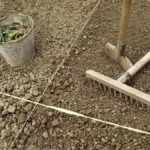Many vegetables can be grown in winter and harvested in winter or early spring. Some vegetables take most of a year to mature; they are planted in spring and harvested in winter. Other vegetables can be sown in midsummer or early autumn for autumn and winter harvest.
Vegetables for winter harvest include leeks, salad leaves, carrots, and onions. Root crops including parsnips, rutabagas, and turnips can be planted in mid to late summer for winter harvest.
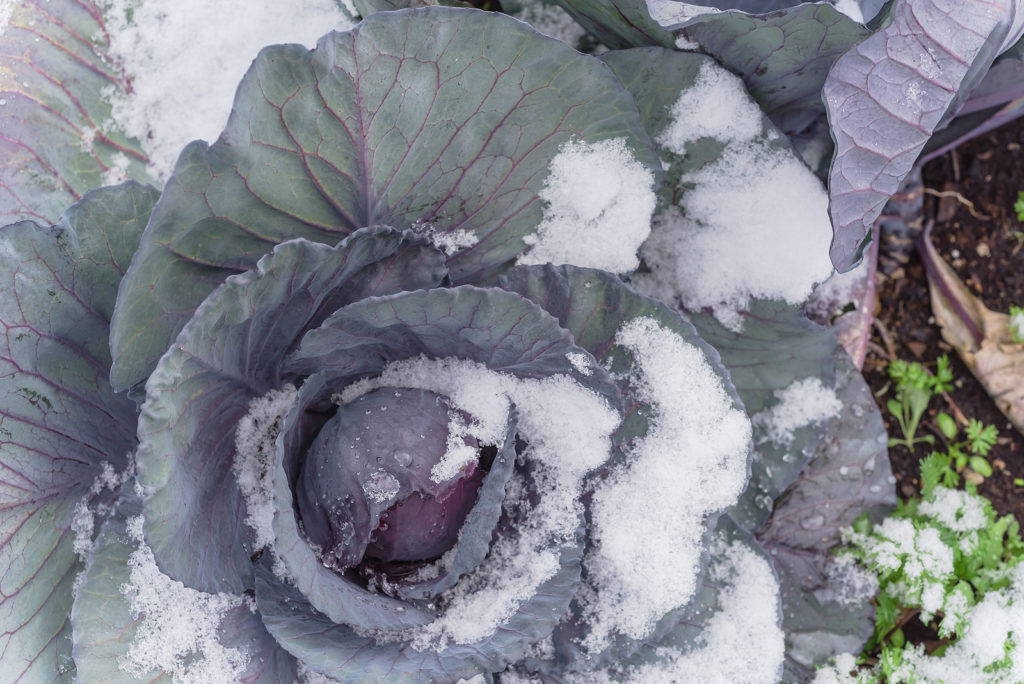
Vegetables for winter harvest
Cool-season crops are best for the winter vegetable garden. Leafy greens and crops such as beets, cabbage, kale, carrots, lettuce, parsnips, spinach, and turnips can be grown in winter. These crops prefer cool temperatures. They use the shorter days of autumn to direct their energy into leaf and root formation and don’t bother with flowering and seeding or fruiting as summer vegetables do.
Cool-season crops for winter harvest can be planted in almost all gardens by the end of summer–earlier in very cold-winter regions where summer is short. Autumn and winter crops replace summer crops as days shorten and temperatures begin to drop. Root crops do best in cool weather as do most leafy crops.
When to plant the winter garden
To know when to plant the winter garden, follow these steps:
- Check the seed packet for the number of days to maturity for the crop you plan to plant.
- Mark the average date of the first frost in your garden on the calendar.
- Count backward from the average first frost date the number of days to maturity for the crop you are planting.
- Count backward an additional two weeks and mark that planting date on your calendar. (The additional two weeks will allow for slower plant growth as day length decreases and temperatures cool as summer fades into autumn and then to winter.)
To cut short the number of days a plant will need in the garden is to transplant out seedlings. Seedlings have a 4 to 6-week head start over the seeds you sow today. Almost all vegetable seeds need warm soil to germinate. Make sure seeds have time to reach maturity before freezing weather or plan to protect plants from freezing temperatures.

Grow winter crops in a cold frame or plastic tunnel
If you expect frost or a hard freeze before harvest, plan to protect the plants from freezing temperatures. Plant vegetables for winter harvest in a cold frame or plastic hoop tunnel or have portable hoop tunnels or cold frames read to set over plants when a frost or freeze threatens.
A cold frame or a plastic hoop tunnel will protect vegetables from cold temperatures. Cold frames and plastic hoop tunnels are season-extending devices. You can grow vegetables in a cold frame or plastic tunnel in containers or directly in the soil or seedbed under the frame or tunnel.
Temperatures inside a cold frame or plastic tunnel will usually be 10 to 20 degrees warmer than the outside temperature. This temperature difference is usually to advance the growing season by several weeks.
Cool-weather crops easily started and grown n a cold frame or plastic tunnel include beets, broccoli, cabbage, cauliflower, celery, lettuce and salad greens, onions, and parsley.
More ways to protect winter vegetables
Row covers
Row covers–light-transmissible fabric–can be draped directly over growing plantings. Floating row covers and plant blankets can be set loosely over plants. Row covers will provide some degree of frost protection, though not as much as cold frames or plastic tunnels. Most row coves will raise temperatures beneath by about 4°F during the daytime. A garden tunnel is a giant row cover, supported by hoops.
Mulch
Protect plant roots and the soil from frost heaves–when the soil freezes, thaws, and then freezes again–with mulch. Frost heaves can push plant roots up and even out of the soil exposing root tissue that can be injured or killed by the cold. Reduce potential damage with a layer of mulch at leaves 3 to 3 inches thick. Use compost, straw, or shredded leaves
Windbreaks
Plants can lose moisture to evaporation caused by strong winds; a plant that loses moisture to evaporation will not be able to replace that moisture if the water in the soil is frozen. Buildings, walls, fences, and plants that offer shelter from the wind–a hedge or shelterbelt of trees–can protect vegetables from the wind. Windbreaks should modify, not block the wind; if the wind is blocked it may channel in another direction with even greater force. A windbreak should allow some of the wind to pass through, this will gentle the wind, not block it. Commercial windbreak fences and homemade burlap screens can cut wind velocity, Windbreak netting or burlap stretched between poles in a zig-zag fashion will permit some wind to pass through.
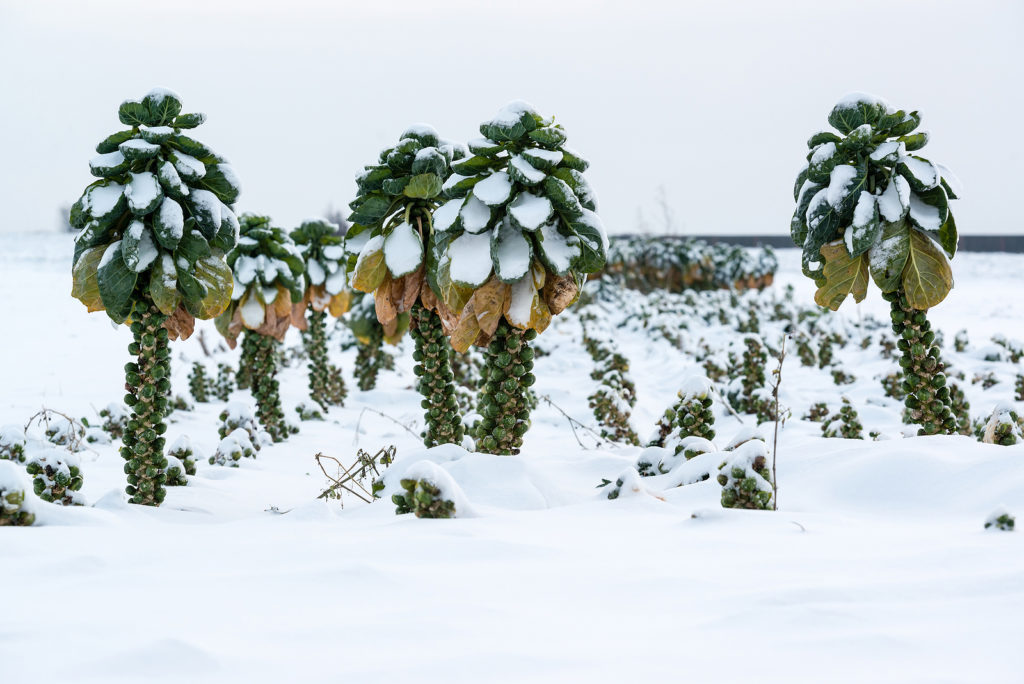
Growing winter vegetables under snow
Snow on the winter vegetable garden does not mean the end of the harvest. Snow will insulate winter crops from freezing temperatures and protect them until harvest. A killing frost or freeze will do more damage to winter vegetables than snow.
Carrots, turnips, Brussels sprouts, and cabbage, chard, and head lettuce can be harvested from under a blanket of snow. Scallions and fall leeks to the size of scallions can be harvested from under snow. Onions can remain in the garden under snow if a protective layer of mulch lies in between. Parsnips and Brussels sprouts will taste sweeter after being covered by snow.
If plant cell damaging freezing temperatures accompany snow, protect crops with mulch, plastic tunnels, or cold frames. Loose straw or fallen leaves can insulate plants from freezing temperatures as well.
The best time for harvesting cold-weather crops from under snow temperatures is when temperatures are in the high 20s or low 30s, especially if you are uncovering only a portion of the crop for harvest and leaving the rest for later harvest.
If freezing weather threatens to freeze the soil, all crops should be lifted from the garden. Frozen soil or sustained freezing air temperature will freeze plant cells and cause them to burst, ruin crops, and kill plants.
Crops that can survive under snow—but not sustained freezing temperatures or ice–include asparagus, rhubarb, beets, broccoli, Brussels sprouts, cabbage, carrots, cauliflower, cress, rutabaga, spinach, endive, horseradish, kohlrabi, kale, leek lettuce, onions, parsley, parsnips, radishes, and turnips.
Reverse season vegetable garden
Reverse season is a term used to describe planting warm-season crops in winter–reverse the time of year one might expect to plant warm-season crops. Reverse seasons gardens are planted in far southern regions of the United States–southern Florida, parts of the Gulf Coast, and far southern California. In these regions, summers get too hot to grow warm-season crops (temperatures average greater than 90°F). Warm-season crops in these regions can be planted in late summer to mature in early winter (reverse the normal season) or they can be planted in mid-to-late winter to mature in late spring. Cool-season crops are planted in mid-to-late autumn to mature in late winter and early spring.
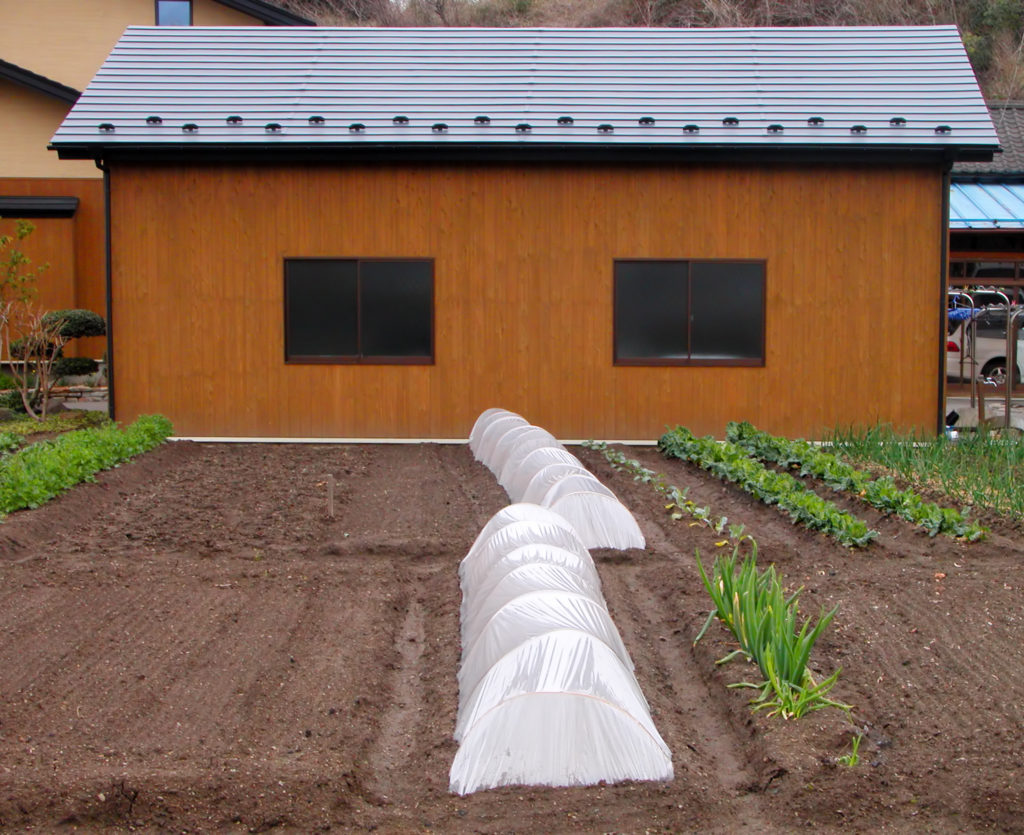
10 steps to start a winter vegetable garden
- Remove the remnants of the summer garden—spent crops—and put green and brown plant materials into the compost pile. Clearing planting beds of spent plants will ensure that summer pest insects and diseases do not overwinter in the garden. Avoid composting diseased or pest-infected plants.
- Turn the soil with a garden spade; turn the soil spade deep (about 12 inches) to aerate the garden and break up clods.
- Add organic amendments to the planting beds—steer manure, chicken manure, seaweed, kelp, and homemade or commercial compost. Use a garden fork to mix the amendments into planting beds already turned with a spade.
- Add blood meal (rich in nitrogen, average NPK ratio 11-0-0), cottonseed meal (rich in nitrogen, average NPK ratio 6-2-1), bone meal (rich in phosphate, average NPK 1-11-0), or bagged organic vegetable food across the planting beds. Follow the directions for each product and work them into the top 6 inches of soil.
- Shape winter garden planting beds so that they are slightly raised at least 3 to 4 inches high and slightly sloped to the south—higher on the north side, lower on the south side; the southern exposure will warm the soil and direct cold air away from winter crops.
- Prepare furrows or planting mounds with a hoe; this is important in heavy soils. Make sure furrows run north and south so that crops get full exposure to the sun in the course of the day.
- Plant tall crops to the north and short crops to the south so that short crops are not shaded by taller crops.
- Remember full sun is needed for winter vegetables; use only planting beds that get all-day sun. Garden beds near south-facing wooden fences, stone walls, or buildings are ideal; they absorb solar heat during the day and radiate it back into the garden at night.
- Have portable plastic row covers or portable cold frames ready to set over crops when the first frost or freeze is forecast. You can arch PVC pipe over beds and stake them in place. When freezing weather arrives cover the arches with clear plastic (4 to 6mil is best); make sure the plastic hangs over on the side and ends to create a mini-greenhouse for crops.
- Add gravel, bark nuggets, or straw to all-weather paths or set raised planks in place to keep your feet out of the mud when autumn and winter rains arrive.
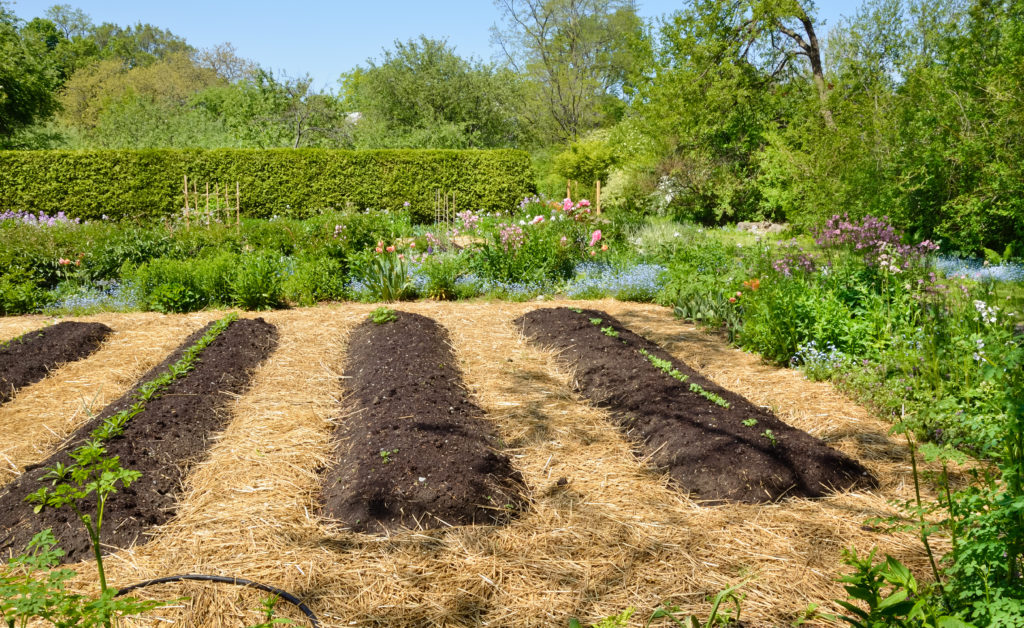
When to sow and harvest winter vegetables
Here are winter vegetable garden crops with their sowing and harvest times (these times are for Zone 8; other zone times may vary by a few weeks plus or minus):
- Arugula: sow July-August; harvest October-December.
- Asian leaves (bok choy etc.): sow August; harvest September-December.
- Asparagus: sow February-March; harvest two years later April-June.
- Broad beans: sow October-November; harvest June-July.
- Dry beans: sow May; harvest September-October.
- Beets: sow May-June; harvest October-December
- Broccoli, purple sprouting: sow May-June; harvest March-May.
- Brussels sprouts: sow April-May; harvest October-April.
- Cabbage, spring: sow August; harvest April-June.
- Cabbage, winter (bullhead): sow May; harvest October-November.
- Cabbage, winter (savoy): sow May-June; harvest November-April.
- Carrot: sow June; harvest October-November.
- Cauliflower: sow June-July; harvest March-May.
- Celeriac: sow March-April; harvest October-April.
- Chervil: sow July-August; October-November.
- Chinese cabbage: sow July; harvest October-November.
- Corn salad: sow August-September; harvest October-April.
- Endive: sow August; harvest October-December.
- Garlic: plant September-October; harvest June-July.
- Jerusalem artichoke: plant March-April; harvest October-April.
- Kale: sow May-June; harvest October-May.
- Land cress: sow August; harvest October-April.
- Leek: sow April; harvest October-April.
- Lettuce: sow late August; harvest April-June.
- Onion/shallot: sow January-March; harvest July-August.
- Parsley: sow July-August; harvest October-December.
- Parsnip: sow March; harvest October-April.
- Potato: plant March-May; harvest August-September.
- Radicchio: sow July; harvest October-May.
- Rhubarb: plant roots November-December; harvest March-June.
- Rutabaga: sow June; harvest October-April.
- Sorrel: sow August; harvest October-December.
- Spinach: sow August; harvest October-December.
- Swiss chard: sow July-August; harvest March-May.
- Winter squash: sow April; harvest October.
- Turnip: sow August; harvest October-April.
Winter no-growth period
Factor into planting and harvest times, the winter no-growth period. When daylight is less than 10 hours each day, plants in the garden will stop growing. If protected from cold they will not die, but they will not actively grow when there are less than 10 hours of sunlight; they will enter a period of dormancy. This is true for all plants including vegetables and herbs.
The no-growth period can last two to three months depending on where you live (check the weather service for sunrise and sunset where you live).
During the no-growth period, leave crops in place and protect them from the cold; when daylight hours are again greater than 10 hours, vegetables will resume growth toward maturity and harvest. Spring cabbage, for example, is planted in late summer or early autumn. It grows to near maturity but then stops growth and sits near dormant during the winter no-growth period then in early spring as daylight increases the cabbage resumes growing, reaches maturity, and is harvested in spring.
Winter vegetable garden month-by-month to-dos
January: sow onion/shallots; harvest beets, Brussels sprouts, winter cabbage, celeriac, chicory, corn salad, Jerusalem artichoke, kale, land cress, leek, parsnip, rutabaga, turnip.
February: sow onion.shallot; harvest beets, purple sprouting broccoli, Brussels sprouts, winter cabbage (savoy), corn salad, Jerusalem artichoke, kale, land cress, leek, parsnip, rutabaga, turnip.
March: sow asparagus, celeriac, onion/shallot, parsnip, and rhubarb; plant asparagus crowns and plants, spring cabbage, Jerusalem artichoke, onion sets and plants, shallot bulbs, potato; harvest arugula, beets, purple sprouting broccoli, Brussels sprouts, spring cauliflower, celeriac, chervil, coriander, corn salad, endive, Jerusalem artichoke, kale, land cress, leek, parsley, parsnip, rhubarb, spinach, sorrel, Swiss chard, turnip.
April: sow Brussels sprouts, celeriac, leek, parsnip, rhubarb, winter squash; plant asparagus crowns, and plants, Jerusalem artichoke, onion sets, and plants, shallot bulbs, potato; harvest arugula, asparagus, beets, purple sprouting broccoli, Brussels sprouts, spring cabbage, winter cabbage (savoy), spring cauliflower, chervil, coriander, corn salad, endive, Jerusalem artichoke, kale, land cress, leek parsley, parsnip, rhubarb, rutabaga, sorrel, spinach, Swiss chard, turnip.
May: sow beans for drying, beets, purple sprouting broccoli, Brussels sprouts, winter cabbage (ballhead), kale, parsnip, rhubarb; plant arugula, beans for drying, spring cabbage, spring cauliflower, celeriac, potato, rhubarb, winter squash; harvest asparagus, bean tops, purple sprouting broccoli, endive, green garlic, lettuce, parsley, rhubarb, sorrel, spinach, Swiss chard.
June: sow beans for drying, beets, purple sprouting broccoli, winter cabbage, carrot, spring cauliflower, kale, rutabaga; plant beans for drying, celeriac, potato, rhubarb, winter squash; harvest asparagus, bean tops, beet tops, purple sprouting broccoli, spring cabbage, spring cauliflower, green garlic, lettuce, parsley, rhubarb, sorrel, spinach, Swiss chard.
July: sow arugula, beets for leaves, carrot, Chinese cabbage, spring cauliflower, coriander, endive, parsley, sorrel, Swiss chard; plant beets, purple sprouting broccoli, winter cabbage (savoy), spring cauliflower, kale, leek, rutabaga; harvest broad beans, garlic, shallot.
August: sow arugula, Asian leaves, beets, spring cabbage, chervil, coriander, corn salad, land cress, endive, lettuce, Swiss chard, parsley, winter radish, sorrel, spinach, turnip; plant Chinese cabbage, chervil, coriander land cress, parsley, sorrel, spinach, Swiss chard; harvest onion, potato.
September: sow Asian leaves, corn salad, green manures; plant spring cabbage, chervil, coriander, corn salad, endive, garlic, land cress, lettuce, parsley spinach; harvest beans for drying, potato.
October: sow broad beans; plant garlic; harvest arugula, Asian leaves, beans for drying, beets, Brussels sprouts, carrot, celeriac, chervil, Chinese cabbage, coriander, corn salad, endive, Jerusalem artichoke, kale, land cress, leek, parsley parsnip, winter radish, rutabaga, spinach, sorrel, winter squash, turnip.
November: sow broad beans; plant garlic, rhubarb; harvest arugula, Asian leaves, beets, Brussels sprouts, winter cabbage (ballhead and savoy), carrot, celeriac, chervil, Chinese cabbage, coriander, corn salad, endive, Jerusalem artichoke, kale, land cress, leek, parsley parsnip, winter radish, rutabaga, spinach, sorrel, winter squash, turnip.
December: plant rhubarb; harvest arugula, Asian leaves, beets, Brussels sprouts, winter cabbage (savoy), carrot, celeriac, chervil, Chinese cabbage, coriander, corn salad, endive, Jerusalem artichoke, kale, land cress, leek, parsley parsnip, winter radish, rutabaga, spinach, sorrel, winter squash, turnip.
Related articles:
How to Grow a Fall Vegetable Garden
Cool Season Vegetable Varieties
Cold Frame to Extend the Season
Garden Planning Books at Amazon:
- Vegetable Garden Almanac & Planner
- Kitchen Garden Grower’s Guide Vegetable Encyclopedia
- Vegetable Garden Grower’s Guide
- Tomato Grower’s Answer Book















